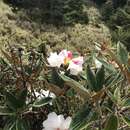en
names in breadcrumbs


There is clearly confusion in the interpretation of the type of Rhododendron hyperythrum. The sense in which the name is applied in this account follows that proposed by E. H. Wilson and most later authors, and refers to a plant characterized by persistent, red, punctate hair bases on the abaxial surface of the leaf blade. Rhododendron rubropunctatum Hayata belongs to this entity. If, as proposed by Li et al. (in T. C. Huang, Fl. Taiwan, ed. 2, 4: 31. 1998), R. hyperythrum is the correct name for the plant described in the present account as R. pachysanthum (in R. subsect. Maculifera), then a new name will be required for the illegitimate later homonym R. rubropunctatum Hayata.
Rhododendron hyperythrum (微笑杜鹃, wei xiao du juan) is a Rhododendron species endemic to north-central Taiwan at 900–1,200 m (3,000–3,900 ft) altitude. It is an evergreen shrub growing to 2.5 m (8.2 ft) in size,[1] with leathery leaves, elliptic-lanceolate to oblong-lanceolate, 7–12 × 2–3.5 cm in size. The flowers are unusual in being pure white.
The plant remains compact in size, and flowers profusely, making it a popular subject for small gardens.[1]
![]() Media related to Rhododendron hyperythrum at Wikimedia Commons
Media related to Rhododendron hyperythrum at Wikimedia Commons
Rhododendron hyperythrum (微笑杜鹃, wei xiao du juan) is a Rhododendron species endemic to north-central Taiwan at 900–1,200 m (3,000–3,900 ft) altitude. It is an evergreen shrub growing to 2.5 m (8.2 ft) in size, with leathery leaves, elliptic-lanceolate to oblong-lanceolate, 7–12 × 2–3.5 cm in size. The flowers are unusual in being pure white.
The plant remains compact in size, and flowers profusely, making it a popular subject for small gardens.